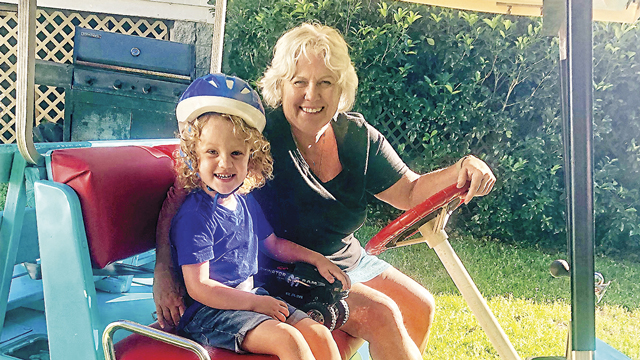7 Ways to Keep Kids and Families Safe in Golf Carts
Originally published in Richmond Family Magazine.
“Climb on and we’ll all go together!”
Golf carts aren’t just for the course anymore. Leave it to parents to find a new use for the golf cart: the mover of all the things and all the people. These slow-moving carts are perfect for hauling beach gear, zipping around at sports tournaments, and in some communities, cruising through the neighborhood to get to the pool. In some cases, what may appear to be a golf cart may actually be a low speed vehicle (LSV) or personal transportation vehicle (PTV). These are slightly faster and more like slow electric cars than carts.
With the increased and diversified use of golf carts and LSVs over the last ten years comes an increase in accidents, particularly among children. According to a study published by the New England Journal of Preventative Medicine, the number of golf cart-related injuries has risen steadily each year and approximately one third of the injuries involve children less than sixteen years old. Falling out of the golf cart was the most common cause of injury, occurring in 40 percent of the cases.
State laws and safety protocols are starting to catch up, though. Below is more information to help your family take advantage of the convenience of golf carts while remaining safe and lawful.
Know the Laws
Technically speaking, golf carts and LSVs aren’t exactly the same and have slightly different laws associated with their use. A golf cart typically reaches a maximum speed of fifteen miles per hour and does not always have the safety features you would see in a car, such as headlights and seatbelts. In Virginia, golf carts may only be driven from sunrise to sunset unless equipped with proper lighting (headlights, brake lights, etc.), and may only be driven on secondary roads where the posted speed limit is twenty-five miles per hour or less. Alternatively, a street-safe cart, or LSV, has a maximum speed of about 25 miles per hour and is equipped with standard safety equipment such as headlights, tail lights, turning signals, and seatbelt systems. LSVs and PTVs may be driven on highways with a speed limit of thirty-five miles per hour or less. Whether you’re driving a golf cart or an LSV, in Virginia, you must be sixteen years old and have a valid driver’s license to be on public roads.
Tips for this Summer
1. Most importantly, follow the rules.
Obeying the laws for golf cart and LSV use is the best way to keep drivers and passengers safe, particularly ensuring that there is an experienced and licensed driver behind the wheel. Additionally, follow the recommendations of the manufacturer. Do not allow more than the recommended number of passengers, do not make post-factory modifications, and never disable or adapt the cart’s speed governor.
2. Teach your children basic safety rules.
Riding in a golf cart is fun for kids, but remember that it is a moving vehicle, albeit at slow speed, and certain safety rules should be followed. Teach children that they should remain seated with their feet on the floor. Seatbelts, if available, should be worn, and passengers should hold on to the armrest or safety bars, particularly while the cart is turning. Children are more likely to fall from rear-facing seats in the cart, so younger children should be put in a forward-facing seat.
3. Shop smart.
If you’re renting or shopping for an LSV or cart to use with children, look for models that have seatbelt systems and forward-facing seats. The more safety features, the better! Also, make sure you know what type of vehicle you’re renting and what the laws are for the town in which you’ll be driving.
4. Remember, you are not driving a car.
In most cases, golf carts and LSVs only have rear axle brakes. When going downhill or making sharp turns, it is easy for carts to fishtail or overturn. Do not expect a golf cart to handle or brake like a car.
5. Make it at least as safe as riding a bike.
We all know the dangers of young heads hitting pavement if they fall off a bike. The greatest risk for children (and all passengers) is ejection from the vehicle. At minimum, put a bike helmet on your children if they are riding in a golf cart or LSV; it will provide protection should they fall or be ejected from the cart.
6. Make sure relatives and friends caring for your children know the rules.
To some, it may seem that wearing a seatbelt or a helmet in a golf cart or LSV is unnecessary or overly cautious. But, the fact is, golf cart accidents are on the rise and the potential for injury when falling or being ejected from the cart is significant. Setting basic rules for your child’s safety on carts is no different than establishing safety rules for bikes and cars.
7. Consider taking a stroll with the baby instead.
The Center for Injury Research and Policy at Nationwide Children’s Hospital recommends that children under the age of six not be transported in golf carts due to a lack of child safety features. So, consider sending the big kids, the grandparents, the cooler, and the zillion beach toys on the cart, and take a nice long walk with the little one.
Golf carts and other LSVs are a true lifesaver for summer fun. Enjoy the convenience as you vacation and get around your neighborhood in the warm weather. Please remember, follow the rules and keep your kids (and yourselves!) safe.

